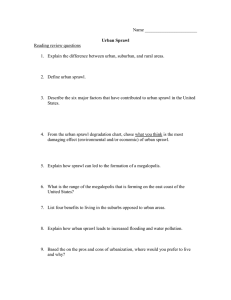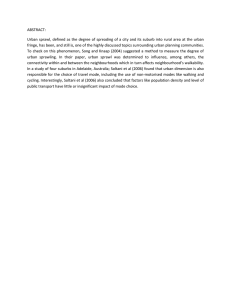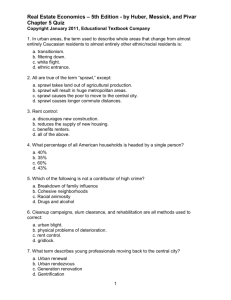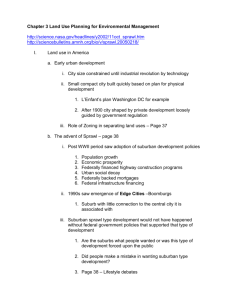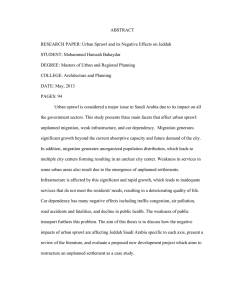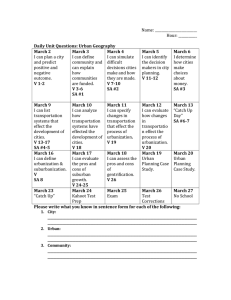Measuring Rural Sprawl George Towers Dept. of Geography Concord University
advertisement
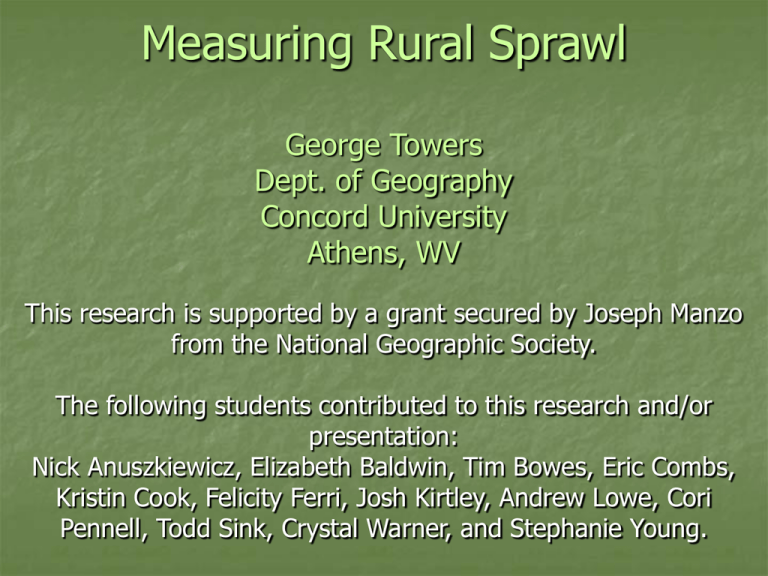
Measuring Rural Sprawl George Towers Dept. of Geography Concord University Athens, WV This research is supported by a grant secured by Joseph Manzo from the National Geographic Society. The following students contributed to this research and/or presentation: Nick Anuszkiewicz, Elizabeth Baldwin, Tim Bowes, Eric Combs, Kristin Cook, Felicity Ferri, Josh Kirtley, Andrew Lowe, Cori Pennell, Todd Sink, Crystal Warner, and Stephanie Young. Outline 2 Study Area: Mercer, Raleigh, What is rural sprawl? and Summers Counties, West Virginia. How to measure rural sprawl? What are the effects of rural sprawl? What are rural sprawl's spatial patterns? Summary What is rural sprawl? “Sprawl is defined as significant development in a relatively pristine setting: rural or undeveloped counties." - Robert W. Burchell, Anthony Downs, Barbara McCann, and Sahan Mukherji In Sprawl Costs: Economic Impacts of Unchecked Development. 2005. Island Press, Washington, DC. 3 Source: Emory University, Atlanta Source: Emory University Sprawl (v.): to spread out carelessly or awkwardly 4 Sprawl is: Individual lots along rural roads (Photo taken on Pine Grove Road) Pipestem State Park § ¦¨ S I-77 U M M E R S Pipestem S.P. #1 #2 #3 E R Camp Creek State Forest & Park M E R Blu Matoaka on est C r ive e R 6 Princeton 8 #4 # *#* 7 **# # 9 Montcalm £ ¤ 460 #5 Bramwell Pinnacle Rock S.P. Bluefield 1 Athens Oakvale Tate Lohr WMA Photos by Eric Combs and Todd Sink Sprawl is: Unincorporated communities (Speedway) § ¦¨ S I-77 U M M E R 3 S Pipestem S.P. #1 #2 #3 E R Camp Creek State Forest & Park M E R Blu Matoaka est on C r ive e R 6 Princeton 8 # *#* * *## #4 7 9 Montcalm Pinnacle Rock S.P. 6 £ ¤ 460 #5 Bramwell Athens Oakvale Tate Lohr WMA Bluefield 3 Sprawl is: Residential subdivisions (Pine View Estates, near Pipestem State Park) 7 Pipestem State Park Sprawl is: Mobile home parks (near Glenwood Park between Princeton and Bluefield) § ¦¨ S I-77 U M M Pipestem S.P. #1 #2 #3 E R Camp Creek State Forest & Park M E R Blu Matoaka on est C r ive e R 6 Princeton 8 #4 # *#* 7 **# # 9 Montcalm Pinnacle Rock S.P. 8 £ ¤ 460 #5 Bramwell Bluefield Athens Oakvale Tate Lohr WMA E R S Wyndale Subdivision Between Athens and Princeton 9 How to measure rural sprawl? Using Housing Data Analyzing secondary area data Creating primary point data 10 US Census counts of housing units Mapping housing structures from aerial photography Density thresholds derived from David Theobald's research Land use category Rural 0-16 Exurban or Rural Sprawl 16-64 Low Density Suburban 64-380 High Density Suburban 380-640 Urban 11 Housing units per square mile 640+ Theobald finds that 29 % of the developable* land in non-metro counties east of the Mississippi was developed by 2000. Source: Theobald, D.M., 2005. Landscape Patterns of Exurban Growth in the USA from 1980 to 2020. Ecology and Society, vol. 10, no. 1. * Non-protected private and public lands . 12 Pct. Developed Land, 2000 67-100% 50-67% 25-50% 10-25% 0-10% Non-metropolitan counties Creating primary point data We mapped the location of 56,937 housing structures in the rural parts of Mercer, Raleigh, and Summers counties using: 13 US Geological Survey maps dating back to 1962 2003 aerial photography from the West Virginia Statewide Addressing and Mapping Board. Sprawl identified with primary data 14 Our results are close to Theobald's Developed land / developable land * Theobald's results Our results Mercer County 51 % 49 % Raleigh County 35 % 34 % Summers County 28 % 36 % 3 county total 38 % 39 % * Developable land is private land outside incorporated communities and census designated places. 15 What are the effects of rural sprawl? Sprawl encroaches on natural resources and exacerbates natural hazards Rural sprawl encroaches on wetlands Rural sprawl encroaches on public lands Rural sprawl heightens flooding hazards 16 17 18 Sprawl's encroachment on wetlands Wetlands by land use 1971 (in sq. mi.) 4.70 (68 %) 2003 (in sq. mi.) 3.56 (51 %) Sprawl 2.25 (32 %) 3.39 (49 %) Total 6.95 (100%) 6.95 (100%) Rural 19 Encroachment on public land 1971 Density* 20 2003 Density Increase in density Pipestem Resort SP 10 56 46 Tate Lohr WMA 23 53 30 All public land 12 31 19 * Density measured by houses per square mile within one mile of public land. The threshold density for rural sprawl is 16. 21 22 23 Sprawl's worsening of flooding hazards Houses in floodplains 1971 2,951 101 / sq. mi. 2003 4,915 168 / sq. mi. 1,964 (+66%) 67 / sq. mi (+66 %) Increase 1971 - 2003 24 Housing density in floodplains What are rural sprawl's spatial patterns? 1. Prevalence of low density sprawl does not equal preference for low density sprawl 2. Rural sprawl is a product of the "power law" 3. Rural sprawl is stealth sprawl 4. Sprawl allows identification of rural growth regions and rural disinvestment regions 25 Low density is prevalent 26 95% of non-rural land is in exurban or low density suburban categories. Low density is prevalent 27 86 % of newly developed land is at exurban densities not suburban densities. Within previously exurban areas, 61% remained at exurban densities in 2003 and was not developed to suburban densities. 1. Spatial prevalence does not equal spatial preference 28 69 % of houses built between 1971 and 2003 were built in already developed areas (39 % in exurban areas and 30 % in suburban areas). 2. Rural Sprawl is a product of the "Power Law" Leapfrog development involves relatively few houses but consumes a relatively large amount of land. 649 new houses in leapfrog patches consumed 2,695 hectares of rural land (10.4 ha / house) 9,403 new houses in expansion zones consumed 48,100 ha of rural land (5.1 ha / house) 22,945 new houses in developed areas 29 consumed no new rural land. Power Law demonstrated by measuring density change M stands for Magnitude of change H stands for Historic density (as of 1971) N stands for New density (added between 1971 and 2003) M = log4N – log4H 30 M values > 1 indicate a categorical change in the level of development. E.g., from rural to exurban. 31 The graph shows the incremental impact in magnitude made by each new house. Notice that most new houses made very little impact while a few made a great impact. Formula: log4(density) log4(density - 5) 20,000 15,000 10,000 5,000 0 0.00 0.20 0.40 0.60 0.80 1.00 3. Rural sprawl is "stealth sprawl" 32 M > 1 for 20,652 ha of previously rural land, only 37% of the 54,764 ha of previously rural land that was developed. Similarly, M > 1 for only 15% of previously exurban land that was developed to suburban densities. Map of M statistic 33 4. Sprawl allows identification of meaningful rural micro-regions 58 regions were identified based on housing density 34 M<-1 M<|1| M>1 11 Lerona (Clustered Rural Sprawl) Crumps Bottom M<-1 M<|1| M>1 49 40 5 1 Crumps Bottom (Entropic Rural Sprawl) 94 Lerona Matoaka Princeton 5 Princeton (Suburban Infill) 28 67 2 39 69 35 Matoaka (Disinvestment) Summary: Contributions to the sprawl discussion 36 Confirming that sprawl is extensive in slow-growing rural areas. Implementing a simple, yet unutilized methodology that goes beyond presence / absence measures and better assesses the consequences and character of rural sprawl. This methodology may be increasingly accessible to other researchers. THE END Thank you for your attention. 37 Summary: What is the prognosis for sprawl in our area? or, What is local leadership's perspective on sprawl? 38 Pro-growth. The landscape is a resource for economic growth. Concerned with incompatible adjacent land uses that limit growth. Considering zoning and annexation to regulate land use. Not concerned with the amount or rate of sprawl that is occurring. Summary Points 39 Rural sprawl in slow-growing regions is significant. Rural sprawl is best measured with housing density. Rural sprawl is encroaching on sensitive environments including wetlands, public lands, and floodplains. Rural sprawl is likely to continue to rapidly consume rural land and needs to be addressed at the local level. Sprawl vs. Smart Growth or, leapfrog development vs. infill development 40 41 42 43 Infill development Location 44 Pct. of houses built from 1972-2003 Within 1971 Sprawl 54.5 Within 1 mile outside 1971 Sprawl 38.5 Within 1971 Sprawl or 1 mile of 1971 Sprawl 93.0 Within 1 mile of an incorporated community or Census Designated Place 41.4 Leapfrog development Location More than 1 mile from an incorporated community, CDP, or USGS rural place More than 2 miles from an incorporated community, CDP, or USGS rural place More than 1 mile from 1971 Sprawl More than 1 mile from 1971 Sprawl AND an incorporated community, CDP, or USGS rural place 45 Pct. of houses built from 1972-2003 22.5 4.2 7.0 5.0 Comparison of Land Uses by Housing Density Threshold Theobald Theobald Galster et 2001 2003 al. Rural Rural Sprawl Suburban Sprawl Urban Sprawl 46 (0-16) 61 % (0-32) 72 % (16-64) 22 % (32-376) 26 % (64-640) (376-2590) 16 % 2% (640 +) 1% (2590 +) 0% Wolman et. al. (0-100) 89 % (0-60) 80 % (100-400) 9% (60-400) 18 % (400 +) 2% (400 +) 2% Comparison of Search Radii Theobald 2001 Rural ¼ mile ½ mile Rural Sprawl ¼ mile ½ mile Suburban Sprawl ¼ mile ½ mile Urban Sprawl ¼ mile ½ mile 47 Theobald 2003 (0-16) 61 % 49 % (0-32) 72 % 67 % (16-64) 22 % 33 % (32-376) 26 % 32 % (64-640) 16 % 18 % (376-2590) 2% 1% (640 +) 1% 0% (2590 +) 0% 0% Galster et al. Wolman et. al. (0-100) 89 % 90 % (0-60) 80 % 82 % (100-400) 9% 9% (60-400) 18 % 17 % (400 +) 2% 1% (400 +) 2% 1% Residential subdivision pattern analysis 48 Suitable for the large residential subdivisions that contribute to sprawl outside cities. Not broadly applicable to the smaller scale development that comprises sprawl within rural areas. Land use pattern analysis Which pattern is sprawl? (Each dot = 1,000 houses; Each small square represents 160 acres or 0.25 sq. mi.) Source: Galster, George, et al. 2001. Wrestling Sprawl to the Ground: Defining and 49 Measuring an Elusive Concept. Housing Policy Debate vol. 12, no. 4, pp. 681-717. Methodological mismatch 50 The previous diagram shows 102,000 houses in 25 square miles (4,080 houses per square mile). Our study area has 56,937 houses in 1,220 square miles (47 per square mile or 1/87th the density of the diagram). Remote Sensing Land Cover Analysis for Private Rural Land, 1992-1995 Sq. Miles Rural % of Total 1187.11 97.44 5.12 0.42 16.32 1.34 Moderate Intensity Urban 0.54 0.04 Intensive Urban 9.26 0.76 31.24 2.56 1218.35 100.00 Populated Areas Light Intensity Urban Populated / Urban Total Total 51 Source: Strager, Jacquelyn M., and Yuill, Charles B. 2002. The West Virginia Gap Analysis Project Final Report. Washington: US Dept. of the Interior. Remote Sensing 52 Corroborates imagery collected from satellites with other data sources to determine land use / land cover categories. Pixel scale and classification methods, however, fail to capture rural sprawl. Remote Sensing Analysis Source: Strager, Jacquelyn M., and Yuill, Charles B. 2002. The West Virginia GAP Analysis Project Final Report. Washington: US Dept. of 53 the Interior. Sprawl Identified by Remote Sensing 54 Houses in the Study Area 55 56 WV non-metropolitan counties averaged 27% developed land in 2000 Pct. Developed Land, 2000 50-58% 40-50% 30-40% 20-30% 8-20% 57 Source: Theobald, D.M. 2005. Landscape Patterns of Exurban Growth in the USA from 1980 to 2020. WV rural counties averaged 23% developed land in 2000 Pct. Developed Land, 2000 50-58% 40-50% 30-40% 20-30% 8-20% 58 Source: Theobald, D.M. 2005. Landscape Patterns of Exurban Growth in the USA from 1980 to 2020.



